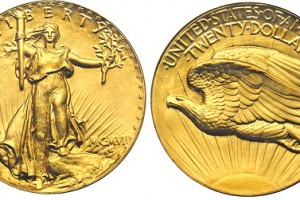There are only two surviving examples of the fabulous 1907 Ultra High Relief double eagle, and there is only one place to see them: the Smithsonian Institution. But what makes these coins so rare – and even illegal?
Jeff Garret writes:
The year 1907 saw a great deal of experimentation at the U.S. Mint. President Theodore Roosevelt was insistent that sculptor Augustus Saint-Gaudens redesign the U.S. coinage. One of the experimental issues produced was a double eagle of the MCMVII (1907) design struck on a normal-weight planchet, but with the diameter of a $10 coin. The resulting coin was much thicker than normal. The Ultra High Relief double eagle was almost double the thickness of a standard double eagle (note the picture of the obverses here). Moreover, each coin required nine strikings from a 172-ton hydraulic press.

